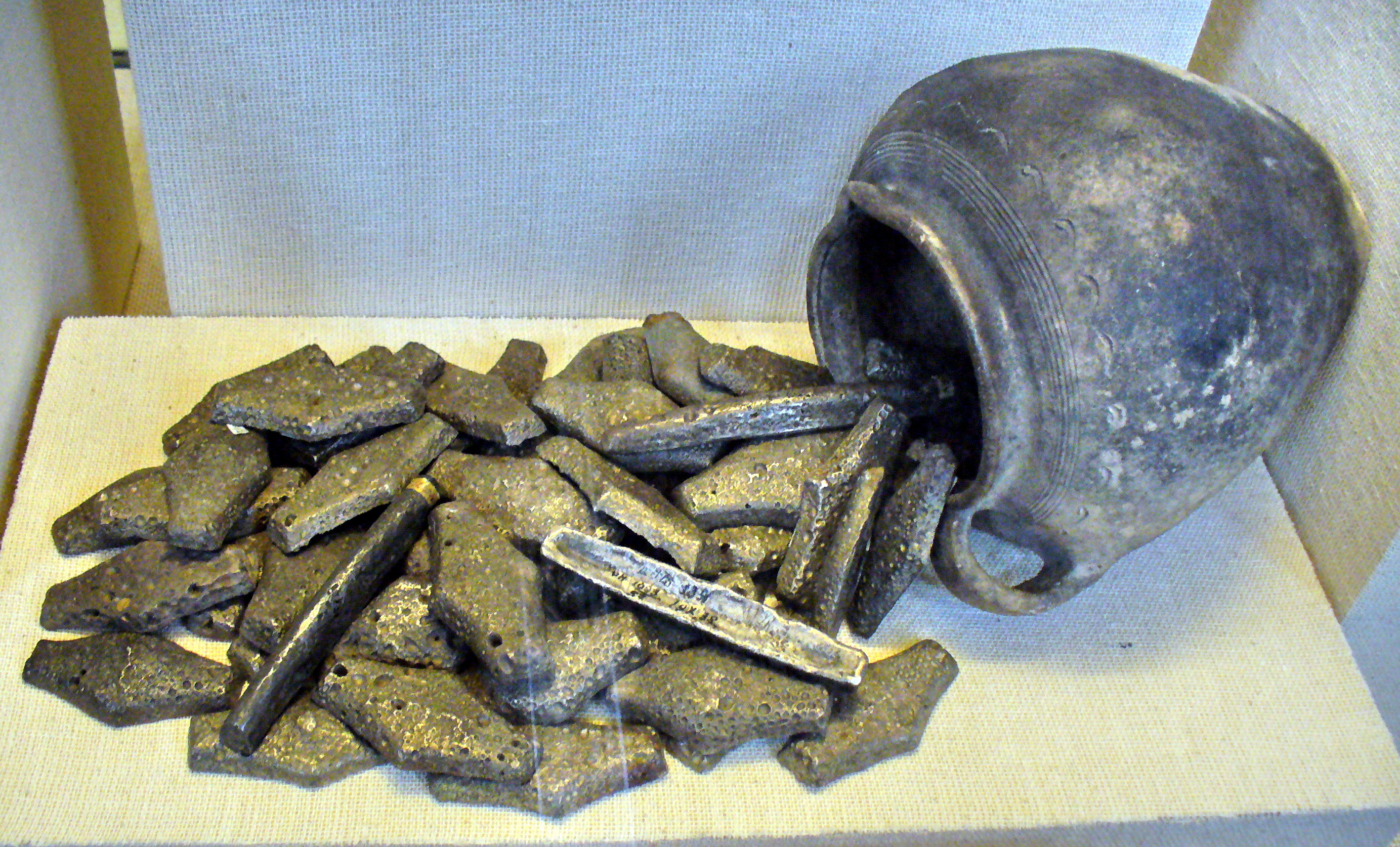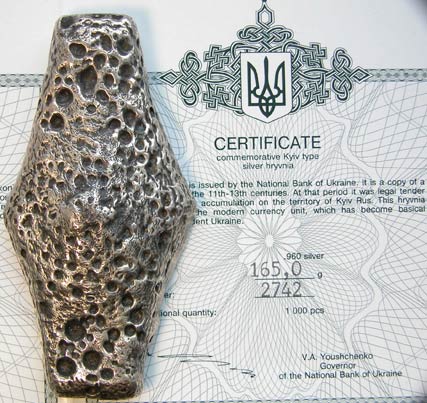|
Grivna
The grivna () was a currency as well as a measure of weight used in Kievan Rus' and other states in Eastern Europe from the 11th century. Name The word ''grivna'' is derived from from . In Old East Slavic, it had the form , ''grivĭna''. In modern East Slavic languages it has such forms: , ''grivna'', , ''hryvnia'', , ''hryŭnia''. The name of the contemporary currency of Ukraine, ''hryvnia'', is derived from the grivna. History Early history As its etymology implies the word originally meant a necklace or a torc, torque. The reason why it has taken the meaning of a unit of weight is unclear. The grivnas that have been found at various archaeological sites are not necklaces but bullions of precious metals, usually silver. The weight and the shape of grivnas were not uniform, but varied by region. The grivnas of Novgorod and Pskov were thin long round-edged or three-edged ingots, while Kievan grivnas have rather the shape of a prolonged rhombus. The material was eit ... [...More Info...] [...Related Items...] OR: [Wikipedia] [Google] [Baidu] [Amazon] |
Hryvnia
The ( ; , ''hrn''; sign: ₴; code: UAH) has been the national currency of Ukraine since 2 September 1996. The hryvnia is divided into 100 kopiykas (). It is named after a measure of weight used in Kievan Rus'. Etymology The currency of Kievan Rus' in the 11th century was the ''grivna''. The word is thought to derive from the Slavic ''griva''; which compares with the Ukrainian, Russian, Bulgarian, and Serbo-Croatian word (''griva'', meaning "mane"). It might have indicated something valuable to be worn around the neck, that was usually made of silver or gold, and may be related to the Bulgarian and Serbian term ''grivna'' (, "bracelet"). Following Ukraine's declared secession from Russia in 1917, the Ukrainian People's Republic named its currency hryvnia after the grivna of Kievan Rus'; these were designed by Heorhiy Narbut. The word was used to describe silver or gold ingots of a certain weight. Currency sign The hryvnia sign is a cursive Ukrainian letter He (''� ... [...More Info...] [...Related Items...] OR: [Wikipedia] [Google] [Baidu] [Amazon] |
History Of Ukrainian Hryvnia
The Ukrainian hryvnia has been the national currency of Ukraine since 1996. It was briefly used in the Ukrainian People's Republic before the Ukrainian karbovanets, karbovanets was adopted as a national currency. The hryvnia is named after the grivna, which was used in Kievan Rus' and other states. Etymology The word “''hryvnia''” in Kievan Rus' first meant a decoration worn at the nape of the neck, which often served as Grivna, a measure of weight at the time. The first mention of "hryvnia" in the meaning of currency is found in "Primary Chronicle, The Tale of Bygone Years" between 8th and 9th centuries. The chronicle relates that Oleg of Novgorod, Prince Oleg the Prophet, coming from the North, began to rule in Kyiv and "established to give the Vikings from Novgorod three hundred hryvnias a year, for peace," indicating that in the hryvnia was used as a measure of weight and counting from the 8th to 9th centuries when conducting trade operations or paying tribute. In the ... [...More Info...] [...Related Items...] OR: [Wikipedia] [Google] [Baidu] [Amazon] |
Kievan Rus'
Kievan Rus', also known as Kyivan Rus,. * was the first East Slavs, East Slavic state and later an amalgam of principalities in Eastern Europe from the late 9th to the mid-13th century.John Channon & Robert Hudson, ''Penguin Historical Atlas of Russia'' (Penguin, 1995), p.14–16. Encompassing a variety of polities and peoples, including East Slavs, East Slavic, Norsemen, Norse, and Finnic peoples, Finnic, it was ruled by the Rurik dynasty, founded by the Varangians, Varangian prince Rurik.Kievan Rus , Encyclopædia Britannica Online. The name was coined by Russian historians in the 19th century to describe the period when Kiev was preeminent. At its greatest extent in the mid-11th century, Kievan Rus' stretched from the White Sea in the north to the Black Sea in the south and from the River source, headwaters of the ... [...More Info...] [...Related Items...] OR: [Wikipedia] [Google] [Baidu] [Amazon] |
Manilla (money)
Manillas are a form of commodity money, usually made of brass, bronze, or copper, which were used in West Africa.Chamberlain, C. C.(1963). The Teach Yourself ''Guide to Numismatics''. English Universities Press. p. 92. They were produced in large numbers in a wide range of designs, sizes, and weights. Originating before the colonial period, perhaps as the result of trade with the Portuguese Empire, manillas continued to serve as money and decorative objects until the late 1940s and are still sometimes used as decoration on arms, legs and around the neck. In popular culture, they are particularly associated with the Atlantic slave trade. Origins and etymology The name ''manilla'' is said to derive from the Spanish for a 'bracelet' , the Portuguese for 'hand-ring' ,Rees, Alun (April 2000). "Manillas". ''Coin News''. . p. 46–47. or after the Latin (hand) or from , plural of (necklace). They are usually horseshoe-shaped, with terminations that face each other and are roughly ... [...More Info...] [...Related Items...] OR: [Wikipedia] [Google] [Baidu] [Amazon] |
Denga
A denga (, ) was a Russian monetary unit with a value latterly equal to kopeck (100 kopecks = 1 Russian ruble). The denga was introduced in the second half of the 14th century during the reign of Dmitry Donskoy. Etymology The Russian word ''denga'' is borrowed from Tatar language, Tatar (cf. Chagatay language, Chagatay: ''täŋkä''; ; ; ). Other proposals made are: Middle Persian: ''dāng'', New Persian: ''dānag'' ('coin'), whereas other authors saw the word close to the Turkic word ''tamga'' ('mark, stamp'). The plural form of ''denga'', ''dengi'' () has become the usual Russian word for "money". History Production of ''dengi'' as minted coins began in the middle of the 14th century, during the reign of Dmitry Donskoy. In their earliest form, they were imitations of the silver coinage of the khans of the Golden Horde, usually bearing blundered or meaningless wikt:legend#Noun, legends. Weighing about a gram, they were prepared by cutting silver wire into measured lengths ... [...More Info...] [...Related Items...] OR: [Wikipedia] [Google] [Baidu] [Amazon] |
Obsolete Units Of Measurement
This is a list of obsolete units of measurement, organized by type. These units of measurement are typically no longer used, though some may be in limited use in various regions. For units of measurement that are unusual but not necessarily obsolete, see List of unusual units of measurement. For units of measurement that are humorous in nature, see List of humorous units of measurement. Area * Antsingae – a unit of area, smaller than the bunarium. * Bunarium (plural "bunaria") – a unit of area, equal to about 120 Hectare#Are, ares or 12,000 square metres * Carucate * Cawnie * Decimal (unit), Decimal * Dessiatin * Ground (unit), Ground * Hide (unit), Hide * Juchart * Jugerum * Katha (unit), Katha * Lessa (unit), Lessa or Lecha * Marabba * Morgen * Oxgang * Pari (unit), Pari – a unit of area equal to about 1 hectare * Quinaria * Tathe * Virgate Energy, etc. * Poncelet – unit of power * Sthène – unit of force * * Length * Ald (unit), Ald * Alen (unit of length), Al ... [...More Info...] [...Related Items...] OR: [Wikipedia] [Google] [Baidu] [Amazon] |
Units Of Mass
Mass is an intrinsic property of a body. It was traditionally believed to be related to the quantity of matter in a body, until the discovery of the atom and particle physics. It was found that different atoms and different elementary particles, theoretically with the same amount of matter, have nonetheless different masses. Mass in modern physics has multiple definitions which are conceptually distinct, but physically equivalent. Mass can be experimentally defined as a measure of the body's inertia, meaning the resistance to acceleration (change of velocity) when a net force is applied. The object's mass also determines the strength of its gravitational attraction to other bodies. The SI base unit of mass is the kilogram (kg). In physics, mass is not the same as weight, even though mass is often determined by measuring the object's weight using a spring scale, rather than balance scale comparing it directly with known masses. An object on the Moon would weigh ... [...More Info...] [...Related Items...] OR: [Wikipedia] [Google] [Baidu] [Amazon] |
Medieval Currencies
In the history of Europe, the Middle Ages or medieval period lasted approximately from the 5th to the late 15th centuries, similarly to the post-classical period of global history. It began with the fall of the Western Roman Empire and transitioned into the Renaissance and the Age of Discovery. The Middle Ages is the middle period of the three traditional divisions of Western history: classical antiquity, the medieval period, and the modern period. The medieval period is itself subdivided into the Early, High, and Late Middle Ages. Population decline, counterurbanisation, the collapse of centralised authority, invasions, and mass migrations of tribes, which had begun in late antiquity, continued into the Early Middle Ages. The large-scale movements of the Migration Period, including various Germanic peoples, formed new kingdoms in what remained of the Western Roman Empire. In the 7th century, North Africa and the Middle East—once part of the Byzantine Empire—came un ... [...More Info...] [...Related Items...] OR: [Wikipedia] [Google] [Baidu] [Amazon] |
Marten
A marten is a weasel-like mammal in the genus ''Martes'' within the subfamily Guloninae, in the family Mustelidae. They have bushy tails and large paws with partially retractile claws. The fur varies from yellowish to dark brown, depending on the species; it is valued by animal trappers for the fur trade. Martens are slender, agile animals, which are adapted to living in the taiga, and inhabit coniferous and northern deciduous forests across the Northern Hemisphere. Classification Results of DNA research indicate that the genus ''Martes'' is paraphyletic, with some studies placing ''Martes americana'' outside the genus and allying it with '' Eira'' and '' Gulo'', to form a new New World clade. The genus first evolved up to seven million years ago during the Miocene epoch. Fossils Several fossil martens have been described, including: *†''Martes campestris'' (Pliocene) *†''Martes wenzensis'' (Pliocene) *†''Martes vetus'' (Pleistocene) Another descri ... [...More Info...] [...Related Items...] OR: [Wikipedia] [Google] [Baidu] [Amazon] |
Obsolete Russian Units Of Measurement
Historical Russian units of measurement were standardized and used in the Russian Empire and after the Russian Revolution, but were abandoned after 21 July 1925, when the Soviet Union adopted the metric system. The Tatar system is very similar to the Russian one, but some names are different. The Polish system is also very close to the Russian. The system existed since Kievan Rus', but under Peter the Great, the Russian units were redefined relative to the English system.Шостьин Н. А. Очерки истории русской метрологии XI – начала XX века. М.: 1975. Until Peter the Great the system also used Cyrillic numerals, and only in the 18th century did Peter the Great replace it with the Hindu–Arabic numeral system. Length The basic unit was the Russian ell, called the ''arshin'', which came into use in the 16th century. It was standardized by Peter the Great in the 18th century to measure exactly twenty-eight English inches (). Thu ... [...More Info...] [...Related Items...] OR: [Wikipedia] [Google] [Baidu] [Amazon] |




